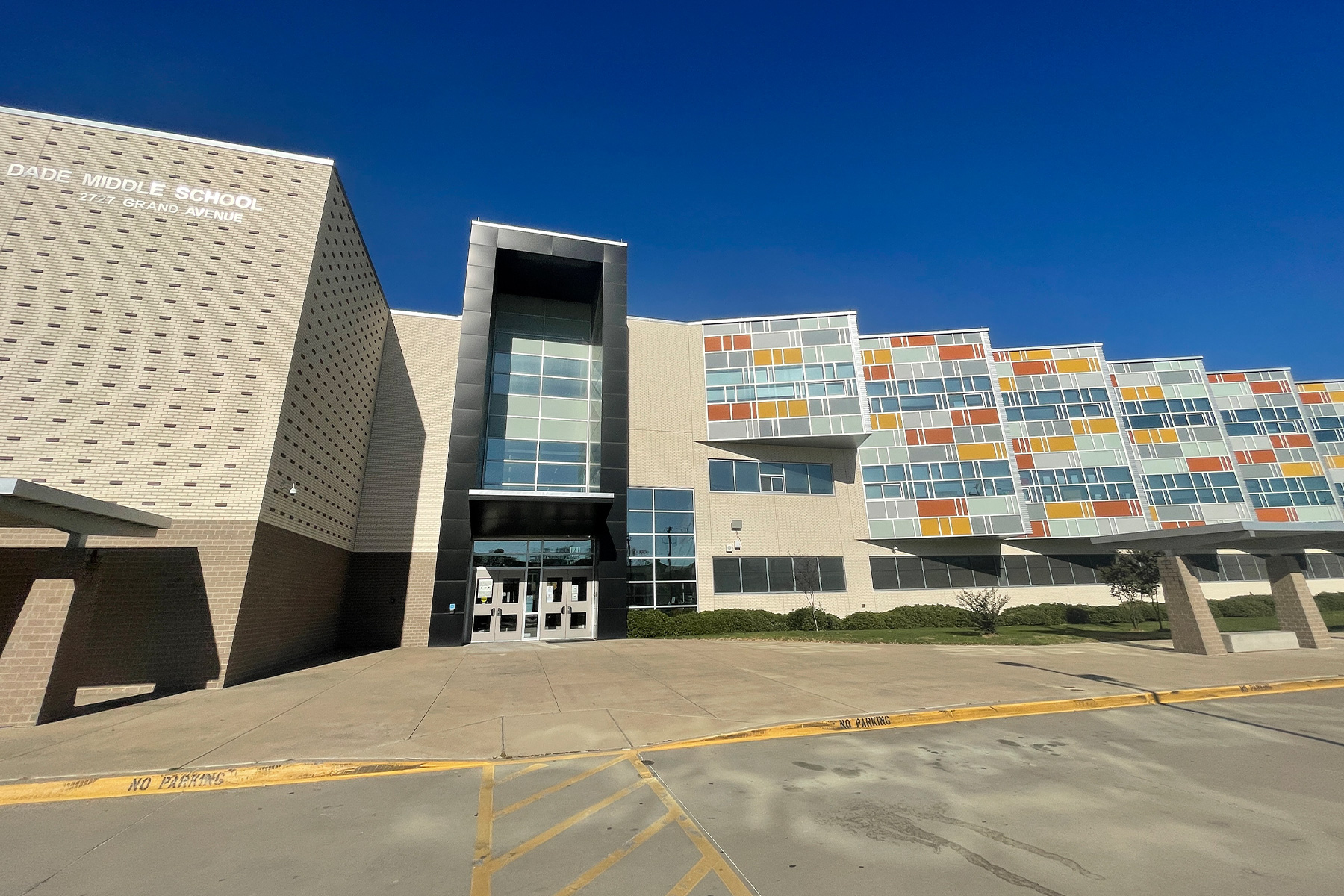You do know what we will have to deal with right after we get done dealing with COVID-19, right? The same stuff we were dealing with before COVID. For children and early education, that will mean resuming the debate on testing and accountability.
A good place to start would be Billy Earl Dade Middle School in South Dallas. I would argue that Dade is the most important public school in Texas, for reasons happy, sad, and then, guess what? Maybe happy again. It’s a story.
Eight years ago, before former Dallas Superintendent Mike Miles came to town, Dade was so dysfunctional, so downright scary, that the district had trouble getting teachers to enter the building. Eric Nicholson wrote a wonderful/horrible story for the Dallas Observer about a teacher at Dade stuffing blankets under her classroom door to protect her kids from pepper spray that the cops were firing to break up fights in the hallway.
This is a middle school. Not a high school. Do I even need to say that basic learning was in the tank at Dade? Test scores were off-the-charts terrible.
Miles instituted districtwide reforms based on a single idea. He took those terrible test scores as cries for help. To Miles, every flunk, every F, every miserable failure on a test was a kid crying out: “Help me. I’m just a kid. I recently arrived on your planet. I don’t know anything. The adults have got me locked up in this scary building. They’re shooting pepper spray at me. I have no idea why I am even here, because I cannot read well enough or do enough basic arithmetic to know what any of this is even about or for.”
Our unhappy truth in Dallas is that poverty, segregation, and language challenges are worse here than other places. According to data published on the Commit Partnership site, Dallas has a significantly higher number of children who are both economically deprived and non-English-speaking than Houston, Los Angeles, Chicago, New York, Miami, Atlanta—more than the number in two-thirds of major American cities. If we look at the other end of the cycle, what happens to those kids later in life, almost two-thirds of White 25- to 34-year-olds in Dallas have earned associate degrees or higher, while barely a third of Black people that age and 15 percent of Hispanics have reached the same educational level. Unsurprisingly, median income in the same age group is twice for Whites what it is for people of color. So the pepper gas in the halls is only a preview and prediction of a harsh social and economic destiny for tens of thousands of poor Black and Hispanic kids all over the city.
But that’s not why Dade is so important. As Nicholson was beginning to report five years ago (he left town for law school), Dade was not unique for its difficulties. We’ve got difficulties all over the place.
Dade is important for its success and then sadly for a temporary descent back into failure. Fiercely opposed by Black southern Dallas board members (a story for another day), Miles pushed through a package of fundamental reforms based on outcomes and accountability. If a school was sending up smoke signals in the form of bad student achievement scores, Miles sent in the cavalry. There was to be no more blaming the children. The thing that had to change was the adults in the building.
Of course, that’s where a lot of the fierce opposition to Miles came from. He was shaking up long-standing patterns of employment in the schools that people had come to associate with community control. He was pushing people around, and, yes, he definitely was pushing people out. Nobody likes to be pushed out.
But the prize was Dade. Dade was target No. 1 for a program Miles called ACE schools (for Accelerating Campus Excellence). All of the testing, the accountability measures, the pay incentives, the recruitment and leadership training were ammo loaded into a cannon of commitment, aimed square at the schools where the cries for help were loudest. The results were almost immediate. At Dade, subject matter mastery began ticking upward across the board. The halls quieted. Dade went from a school so bad it was on the verge of forced closure to one of the district’s most improved.
It works. That’s the thing. The ticket. The answer to all of the counterarguments. It works. With the right focus of resources, the right school leadership, and the best teachers, those little kids at Dade can be good students and learn to read and do arithmetic just like any other little kids on earth.
We hear a lot about the challenges children face in this time of pandemic, and those challenges are real and terrible. But, look, even without a pandemic, the kids at Dade face challenges just walking to school. Former Dallas school board president Miguel Solis, a staunch supporter of the Miles reforms, told me once about an experiment he did, walking to school with kids in that part of town. Just to get down the block, those kids had to navigate pimps and prostitutes, stumbling drunks and passed-out drug addicts—and those problems popped up after whatever hurdles the kids faced just to get out the door.
These kids come from a tough street. Plus, they’re hungry, and I don’t mean metaphorically. I looked at Dade’s current numbers to see how many kids qualify for free school lunches. It’s 878 of 879 students. I’m not sure I’d want to be that 879th kid.
The Dallas public school system under the Miles reforms taught right through all of that, overcame it, and pulled Dade up by the bootstraps. And then it didn’t.
Miles lasted three years, forced out five years ago. Solis, school board member Dustin Marshall, and Superintendent Michael Hinojosa did their best to hold the line on reforms after Miles was gone, but the reforms cost money, and the money didn’t last. The special resources focused on Dade began to dry up, and Dade began to wither, almost immediately. In fact, no scientist could have devised a cleaner proof of the effectiveness of the reforms than what happened at Dade.
Start with a place that’s off-the-charts awful. Inject a major dose of testing, accountability, and focused resources. Shake up the adults and let those chips fall where they may. The scores go up and the pepper spray goes away.
Withdraw those same resources. Withdraw the accountability. Let things drift again. Stop shaking. The scores turn right back down, and the trouble brews again.
But that’s still not the end of the Dade story or the full reason why Dade is so important to Texas. Dade, this year with new leadership and another dose of resources, is now on another rebound, clocking some of the district’s best improvement scores again in reading and math. So how does that happen?
The money came back. In June of last year, the Texas Legislature passed and the governor signed HB3, a massive education bill with $6.5 billion in new spending. In the politicking to get HB3 passed, the story of the Dallas reforms and the saga of schools like Dade were central and essential. Only when shown those outcomes did conservative legislators come across the aisle to join liberals in committing to this major new spending.
People on both sides of the aisle saw the same thing. The testing is the cry for help. The accountability is the action. The miracle is Dade.
That conservatives and liberals in Austin could come together on that much money indicates that most people really do care. But nobody wants to see good money thrown away on things that won’t do any good.
For now, Gov. Greg Abbott has suspended statewide STAAR tests to measure subject matter mastery, and the Texas Education Agency necessarily has suspended “letter grade” performance scores for schools based in part on those STAAR tests. A certain drumbeat out there opposes the idea of going back to where we were on those issues pre-pandemic and pre-George Floyd. In recent months, the campaign against accountability has begun to pick up again around the country. Here, I am seeing a new element added, an argument that the state’s letter-grade system of school assessment is racist. So far I have seen it mainly on social media, a good place for it, with one exception.
Last fall, the letter-grades-are-racist argument did pop up in mainstream media in a piece written by Dallas Morning News columnist Dave Lieber. Lieber equated the state’s system of letter grades for schools, now in abeyance due to COVID, with a 1930s program of the Federal Housing Administration called redlining. Lieber cited a new book about redlining, The Color of Law, by Richard Rothstein, in which the author unpacks the way redlining operated as a racist rationalization for withholding public resources. Lieber says bad grades for minority schools will work the same way.
I would argue that bad grades for schools work in exactly the opposite way. Under the Dallas system of reforms, re-funded by HB3 and now a statewide mandate, bad letter grades for bad schools are the bugle call. Look out. Here comes the cavalry.
Write to [email protected].






